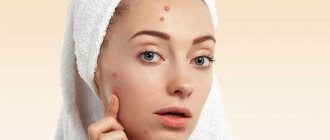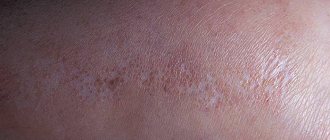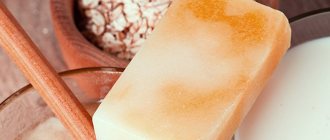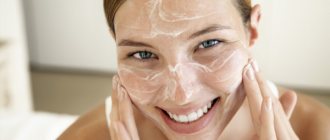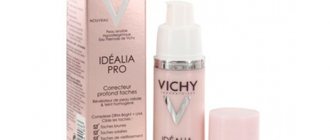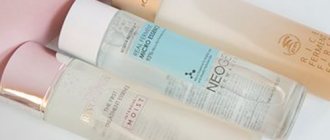Why does skin dry out?
The main cause of dry skin is a breakdown of the epidermal barrier.
Just as a wall is made of bricks, the epidermal barrier is made of dead stratum corneum scales (corneocytes). These scales hold each other like hands with the help of protein bridges (desmosomes). And the layer (cement) between the bricks of the skin is formed by lipids (also called fats).
When the barrier is damaged, lipids “march” out of the skin in orderly rows. The skin's protective system weakens. Moisture is not retained and intensively evaporates from the surface of the skin.
Other causes of dry skin
- cold;
- heat;
- low air humidity;
- UV radiation;
- wind;
- central heating;
- air conditioned;
- age (estrogen levels drop, the skin becomes thinner, sebum synthesis decreases, the protective barrier weakens);
- heredity;
- aggressive cosmetics (sulfates, alcohol, strong retinoids);
- constant contact with water;
- medications (contraceptives, retinoids, medications for high blood pressure, cholesterol, allergies);
- chronic conditions (hypothyroidism, hyperthyroidism, diabetes mellitus, vitamin A deficiency);
- pregnancy;
- poor diet, alcohol and caffeine;
- smoking;
- stress.
Dry skin will experience an acute deficiency of 2 things:
- lipids;
- moisture.
At the same time, dry skin always needs lipids and not always moisture. Dry skin is not always dehydrated. What is the difference? Let's figure it out.
Additional care
It is advisable to complement regular cleansing, toning, moisturizing and nutrition with intensive care procedures. First of all, these are masks, compresses and steam baths. Choose them depending on the characteristics of dry skin.
Steam bath with medicinal herbs
One of the most effective and proven ways to restore dry skin to freshness and beautiful color. Steam stimulates blood circulation, opens and cleanses pores. It is better to carry out the procedure in the evening.
How to do
You will need 10 g of dry herbs: mint, licorice, nettle, bay leaf, grated ginger root. Pour the mixture into 1 liter of water, bring to a boil and simmer for 20 minutes. Then pour the broth into a container convenient for you. Bend your previously cleansed face over the container and cover with a terry towel. Bath time is 5–10 minutes. Wipe your face with toner and then apply cream.
Masks
Let us remind you that a mask is an intensive skin care product. Its purpose is fast, effective and targeted action. The mask contains several times more active ingredients than the cream and has better penetrating ability. Masks differ according to the effect they have on the skin. Nourishing, moisturizing, cleansing, mattifying, rejuvenating, toning. Choose and alternate them depending on the needs of your skin at the moment. As a rule, dry skin needs hydration and nutrition.
Moisturizing masks
They are based on components that intensively moisturize the skin, as well as substances that lock moisture inside it. These are hyaluronic acid, glycerin, butylene glycol, propylene glycerol, beeswax, lanolin, silicone, vegetable oils (avocado, olives), as well as plant components (primarily aloe extract). Such care products can be used as often as you like, even every other day.
Nourishing masks
The skin may be deficient in various substances: fats, vitamins or minerals. Therefore, the composition of nourishing masks is varied. They contain vegetable oils (for example, shea butter, almond oil), royal jelly, proteins, vitamins (primarily A, E and group B), as well as plant extracts (ginseng, vanilla, blue lotus, rose petals, chamomile ) and minerals. It is recommended to do nourishing masks 1-2 times a week, alternating with moisturizing ones.
>.
Orange mask for aging dry skin
Mix 4 tbsp. l. full-fat cottage cheese with the juice of 1 orange and 2 tsp. vegetable oil. Apply the resulting mixture to your face. Keep the mask on for 15-20 minutes. Then rinse your face with warm water.
Potato mask for skin elasticity
Boil 2 potatoes in their skins, cool slightly, peel and mash. Add 1 tsp to warm puree. olive oil and glycerin. Apply the mixture to your face. After 15-20 minutes, remove the mask and rinse your face with warm water.
Flax mask for smooth skin
Pour 2 tbsp. l. flaxseed 2 tbsp. water and boil until mushy. Cool the resulting mixture, apply warm to the face, neck and décolleté, cover with parchment paper and a terry towel on top. Leave on for 15-20 minutes, then remove and spray your skin with cool water.
Difference between dry and dehydrated skin
Dry
- Skin type or temporary skin condition. The skin is dry all year round or becomes dry from normal or even oily in winter.
- Dry skin lacks lipids .
- In this case, the amount of water is no less than in normal or oily skin.
- There is a feeling of tightness.
- The skin is peeling.
- The skin has difficulty absorbing cosmetics.
- Dry skin is prone to hypersensitivity and irritation.
Dehydrated
- Temporary skin condition. Occurs in any skin type (from dry to oily).
- Dehydrated skin lacks moisture.
- There is a feeling of tightness and dryness with visible oiliness and inflammation (dehydrated oily facial skin).
- Dehydrated skin instantly absorbs moisture. Moisturizing creams, masks, serums “sink” into the skin.
LaraBar Tips & Tricks
- For dry facial skin, choose creams with the word “nourishing” (nourishing).
- For dehydrated facial skin, choose creams with the words “moisturizing”, “hydrating” (hydra, hydrating).
- For dehydrated, dry facial skin, combine moisturizing and nourishing serums, creams and masks.
What home treatments will help problematic epithelium?
Steam bath - a remedy for redness and acne
For problematic, rash-prone skin, a steam bath is an excellent treatment. It is enough to warm up some water, add herbal infusions, aroma oils of chamomile, eucalyptus, rosemary, lavender. After this, you can simply bend over the heated composition, covering your head.
As an alternative, moisten a towel or napkin with a nutrient solution and place it on your face for a few minutes.
The steam bath expands the pores as much as possible and promotes the rapid removal of toxins.
The use of aromatic oils will give the epithelium an additional boost of energy and cleanse it of bacteria.
After the steam procedure, you should wait 10-15 minutes, and then apply any nutrient.
In general, the method is simple and accessible to everyone. The only contraindication for a steam bath is an abundant vascular network on the surface of the skin.
Nourishing masks are a real salvation for dry skin
Here are some nutritional formula recipes:
- Cosmetic white clay quickly copes with enlarged pores, eliminates oily skin, and smoothes out fine wrinkles. To prepare a healing composition, just dilute a little white clay with sour milk and kefir to form a paste-like slurry. Apply the resulting mass to the epithelium after washing, leave for 10-15 minutes, remove with a damp swab.
- One of the best for problematic epithelium is a mask made from ordinary rice. To do this, take ½ cup of cereal, pour in 250 ml of boiling water, leave for 1.5-2 hours. Then drain the water, add 100 grams. mashed potatoes and fresh potatoes or cabbage. The components are thoroughly mixed and then applied to the face for 15-20 minutes. The mask is good for oily and dry epithelium, it helps eliminate shine and soothe inflamed dermis.
- After washing, a mask of soda and oatmeal will be useful. At first 200 gr. Grind the oatmeal in a blender, add 20-25 grams. baking soda. Mix the ingredients well, after which for the mask it will be enough to take 1 tbsp. l. mixtures, dilute them with water. The resulting product is applied with massaging movements to cleansed problem skin and left for 10-15 minutes. then removed with a tampon.
Treatment of dry facial skin
The main task when restoring dry facial skin is to “repair” the epidermal barrier.
So, what to do if you have dry skin on your face?
- Cleansing should be gentle (no soap or sulfates).
- And exfoliation is gentle (gommages and soft peelings).
- Use moisturizing and soothing toners. No alcohol.
- Add thermal water to your care.
- Choose the right cream. It should moisturize and nourish (contain lipids and humectants).
- Include nourishing serums with ceramides in your care.
- Be sure to apply SPF protection (sun-damaged skin is unable to retain moisture, the lipid layer is destroyed, the skin's immune system weakens, and regeneration slows down).
- Add oils (shea, argan, coconut, jojoba) to your care.
- Take fish oil and flaxseed oil (sources of omega-3 acids).
- Drink plenty of water.
- Buy a humidifier.
Who to Avoid
- Soap.
- Sulfates (alkali and anything that foams a lot).
- Alcohol.
- Irritating components (triclosan, menthol, mint, citrus, eucalyptus).
- Fragrance.
- Aggressive preservatives (imidazolidinyl urea, bronopol, iodopropynyl butylcarbamate, DMDM hydantoin).
- Hot water.
- Scrubs.
- Loofah sponges and stiff brushes.
- Rubbing.
- Frequent swimming in the pool (especially a chlorinated one).
Cleansing dry facial skin
- Remove makeup with milk, cream, rich cream or oil.
- Wash only with gentle sulfate-free cream foams. It's good if your foam contains oils or ceramides. Like, for example, the Rosehip Oil Cleanser.
- If even soft foams cause discomfort, try cleansing with milk or micellar.
- In case of extreme dryness (xerosis, atopy - the skin becomes crusty and cracks), wash with herbal decoctions.
- Forget scrubs. Stay away from hard abrasives, nut shells and fruit shells.
- Instead of scrubs, use gommages or soft peels. The best acid for dry skin is lactic acid.
- Use soft sponges and sponges to remove flaking. No loofah or hard brushes.
How to choose a cream for dry skin
Texture
For dry skin, choose rich oil- or water-based textures. For very dry skin, use thick, oil-based protective creams.
Lipids
The first thing we look for in a cream for dry skin is lipids (aka fats). Lipids restore and maintain the integrity of the epidermal barrier and hydrolipid mantle and “lock” moisture into the skin. Oils, ceramides, fatty acids, cholesterol, fatty alcohols are all lipids.
Humidifiers
Humectants add moisture to the skin, bind it and keep it inside. Look for glycerin, hyaluronic and lactic acids, sugars, collagen.
Film formers (occlusive components)
Creates a thin moisture-proof film on the skin. It prevents evaporation and “locks” moisture inside. Film formers reduce irritation and help restore the hydrolipid mantle.
The most effective film formers are petroleum jelly in a concentration of 5%, lanolin, mineral oil and silicones. That's why they are so often found in products for dry atopic skin.
Emollients
When the skin lacks moisture and lipids, it begins to peel. The scales of the upper layer of skin (corneocytes) become extremely dry, hard, rough and “bulge out” to the sides. As a result, “holes” are formed between them, through which water intensively evaporates.
Emollients fill the space between the “fluffy” scales. They lubricate, soften and increase the plasticity of corneocytes, smooth the surface of the skin and help “patch” the epidermal barrier. Lanolin, squalene, glycerides, propylene glycol, silicones, mineral oil, petrolatum, petroleum jelly are all emollients.
Anti-inflammatory components
Dry skin often itches, crusts, and cracks. Infection easily penetrates through wounds, causing inflammation. Therefore, anti-inflammatory and soothing ingredients in cosmetics for dry skin are extremely important. Look for aloe, bisabolol, panthenol, allantoin, zinc, niacinamide, chamomile, calendula. Many antioxidants have anti-inflammatory properties.
Important! Don't be afraid of "empty" pharmaceutical formulations, silicones and mineral oils in dry and very dry (atopic) skin care products. This composition of cosmetic products is a necessity.
Yes, not everyone likes to put mineral oil on themselves, but its use in products for dry skin is more than justified. It “seals” moisture into the skin better than others. Silicones do not cause allergies, retain moisture and allow you to create a lighter texture that is more pleasant to apply. And a lot of “natural” active ingredients for dry, cracked, inflamed skin only increases the risk of irritation and allergies.
If you prefer only natural products, actively use oils (shea, argan, jojoba, coconut) in your care. Or try new pharmaceutical products with simple formulations without emulsifiers. For example, .
Read more about how to choose an effective cream for dry skin:
- How to choose the right face cream;
- Skin moisturizing. Natural moisturizing factor;
- Anatomy of a moisturizer.
Stages of daily cleansing at home
Routine facial care consists of a multi-step morning and evening cleansing:
- Removing makeup and impurities. To do this, use micellar water and cosmetic milk. You can choose cleansing gels, foams, mousses. Combining first “micellar” and then products that require rinsing with water will also not be a mistake.
- Toning. After washing, you need to use a liquid that will moisturize the skin, normalize the acidity of its surface, and ensure better absorption of the cream. This is a tonic. You should moisten a cotton pad with it and wipe your face along the massage lines.
- Moisturizing, nutrition, protection. The cleansing procedure is completed by applying a cream appropriate to the time of day.
1 - 2 times a week you need to use deep-impact products. These are scrubs, peelings, gommages, masks, rolls. They will free the surface and pores of the skin from dirt, fat, and dead particles. Deep cleansing products are used after removing makeup. Before applying them, the skin can be steamed using a facial bath with herbs.
We recommend reading about vacuum facial cleansing. You will learn about the benefits of the procedure, indications and contraindications for it, methods of its implementation, and results. And here is more information about why acne occurs after cleansing your face.


